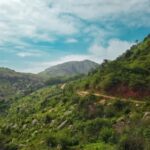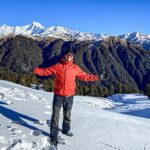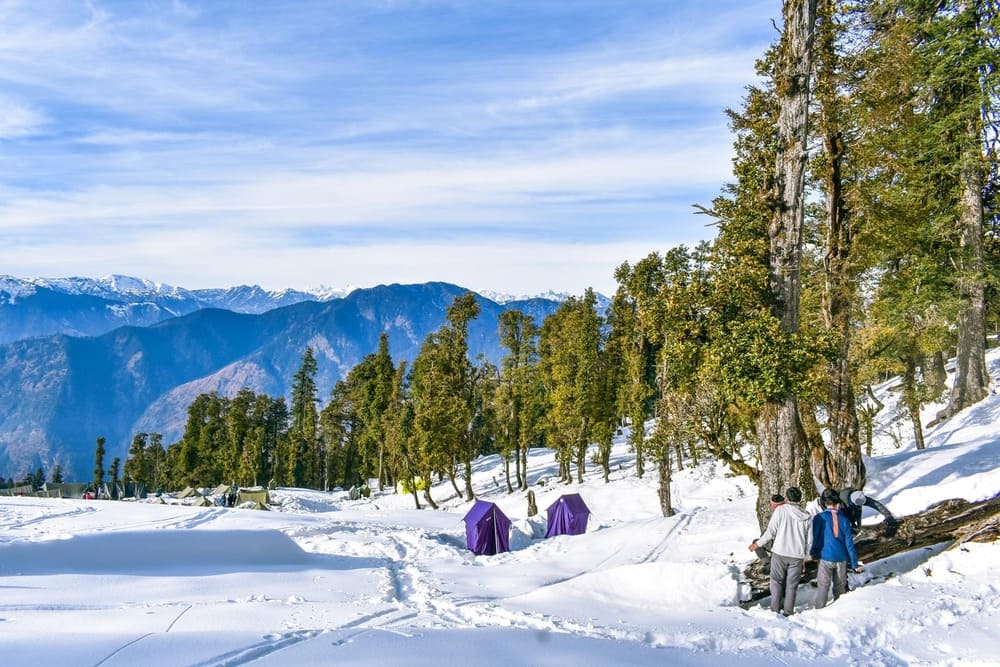
Planning a Kedarkantha trek sounds exciting, but it often comes with confusion and self-doubt.
How long will the trek be?
Will I be able to complete it comfortably?
What about the weather, the terrain, and the preparation?
These questions often stop trekkers from moving forward. Are you also feeling the same?
But don’t worry!
To make your planning easier, I have clearly explained the Kedarkantha trek distance, routes followed by top trek organisers, the best time to visit, approximate cost, height, and day-wise breakdown.
So, keep reading!
- What Makes Kedarkantha Trek So Special?
- Kedarkantha Trek Height
- Kedarkantha Trek Distance Overview
- Popular Kedarkantha Trek Routes
- Comparing Three Routes
- Day-by-Day Difficulty and Trail Breakdown (Sankri Route)
- Kedarkantha Trek Best Time
- Kedarkantha Trek Cost and Package Details
- Preparation Tips for Smooth and Enjoyable Trek
What Makes Kedarkantha Trek So Special?

Kedarkantha is often called the “Queen of Winter Treks”, and there’s a reason it holds that reputation.
The Kedarkantha trail is known for its untouched beauty, snow-laden forests, and wide-open summit views that feel almost cinematic. Moreover, the moment you step into the trail, you start experiencing a blend of adventure, serenity, and mountain culture that leaves a lasting impression.
What truly sets Kedarkantha apart is that it is beginner-friendly, yet offers every element that a Himalayan trek is admired for. There is a comfortable balance between challenge and accessibility, making it ideal for:
- First-time trekkers
- Solo travelers
- Trekking groups
- Winter adventure lovers
As you move through the trek, the landscapes transform beautifully. The route takes you through dense pine forests of Govind Pashu Vihar National Park, wooden bridges, frozen streams, and snowfields that stretch wide under the winter sky. Such a journey feels immersive and peaceful while still giving you the thrill of walking in the Himalayas.
Moreover, the campsites on this trek are exceptionally scenic, especially during the peak winter months. Another memorable experience is camping near Juda Ka Talab, a lake that often freezes during winter, adding dreamlike charm to the campsite. Nights here are silent, star-filled, and deeply calming.
Moving on, the trek begins from Sankri village, and this is where you also get a taste of local mountain culture. Traditional wooden homes, warm-hearted villagers, and slow-paced mountain life create an experience that feels grounding and authentic. This cultural element adds depth to the overall journey, making it more than just a physical trek.
Furthermore, as you ascend towards the Kedarkantha Base Camp, the terrain begins to open up, and the summit slowly comes into view. The final summit push is often the highlight of the trek, especially when the trail is covered in snow. It’s adventurous, slightly steep, and incredibly rewarding.
And then comes the moment that makes everything worth it, the sunrise from the summit. Reaching the top at around 12,500 ft, you are treated to a 360-degree panoramic view of the Himalayan ranges. From the summit, you can clearly see:
- Mt. Swargarohini
- Mt. Bandarpoonch
- Mt. Kalanag (Black Peak)
- As well as Jaonli, Gangotri ranges, Draupadi Ka Danda, and Jorkanden peaks
Watching the first rays of sunlight slowly fall on these mountains is a moment that stays with trekkers long after they return home.
All of these elements come together to create a trek that is not just visually stunning but also emotionally memorable. It is a journey that introduces you to the mountains at a comfortable pace, while still giving you a strong sense of accomplishment at the summit.
Kedarkantha Trek Height
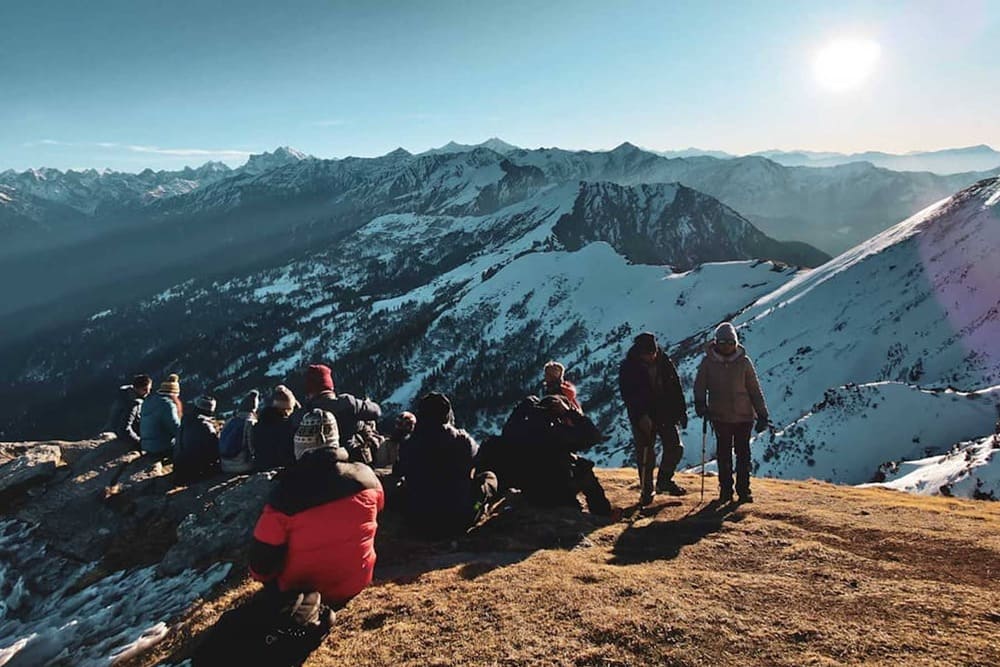
The Kedarkantha trek height rises to about 12,500 ft (around 3,800 meters) above sea level, placing you right in the midst of the high Himalayan landscape.
As you begin the trek, the trail gradually gains elevation, rather than climbing sharply all at once. Because of this, your body gets enough time to adjust to the altitude naturally. Moreover, the route passes through forests, meadows, and gentle snow slopes, which adds a steady rhythm to the climb.
This gradual ascent is one of the key reasons why Kedarkantha is considered beginner-friendly.
With a comfortable pace, proper hydration, and timely breaks, most trekkers are able to reach the summit smoothly and truly enjoy the journey as much as the destination.
Kedarkantha Trek Distance Overview
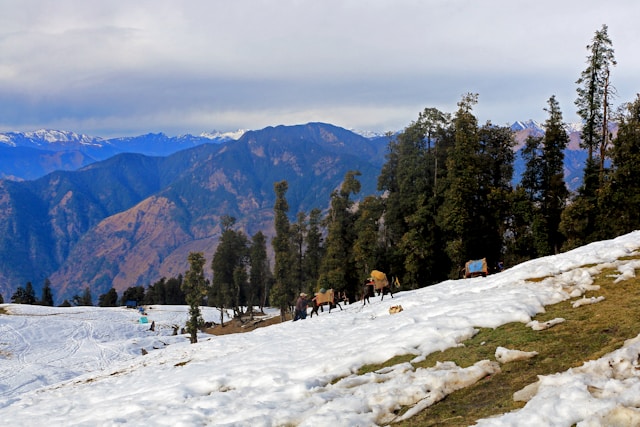
The Kedarkantha trek distance varies slightly depending on the route and the trekking organisation you choose. However, the average trekking distance is:
- Total trekking distance: 20 km to 23 km (round trip)
- Duration: 4 to 6 days, depending on itinerary and acclimatisation
The journey is normally broken into smaller segments so you do not feel pressured.
Popular Kedarkantha Trek Routes
There are three commonly followed routes to complete the Kedarkantha trek.
Route 1: Sankri → Juda Ka Talab
Route 2: Kotgaon – Base Camp Route
Route 3: Gaichawan Gaon – Base Camp Route
While each leads to the summit, the trail style, scenery, and crowd levels differ somewhat. Therefore, understanding these options will help you choose the route that fits your trekking style.
Route 1: Sankri → Juda Ka Talab
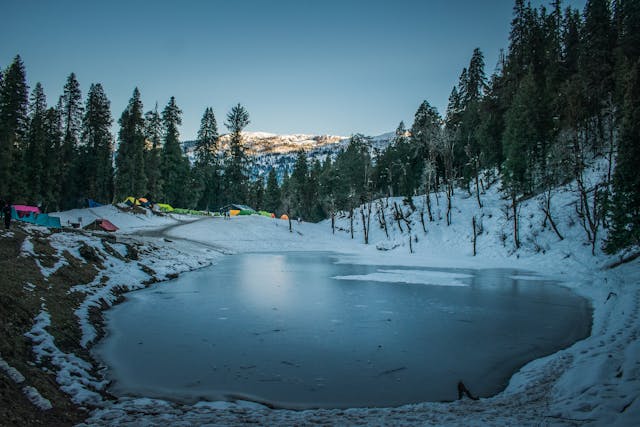
This route begins at Sankri, a lively mountain village with warm hospitality and traditional architecture.
From here, you trek to Juda Ka Talab (approximately 4 km), then ascend further to Base Camp and summit, covering a total of 20 km. This trail is somewhat steeper in parts, yet well-marked and supported – perfect for first-time trekkers who prefer a more social vibe with campsites that are popular and well-established.
Route 2: Kotgaon – Base Camp Route
Another excellent option starts at Kotgaon.
This route covers approximately 23 km total distance and features both forested trails and clearer, wide-open camping zones. It offers a slightly quieter experience than the first, with a serene first-night stay at Kotgaon village, and continues through scenic forest stretches to the summit.
Overall, it’s a balanced choice for trekkers wanting both comfort and a peaceful mountain experience.
Route 3: Gaichawan Gaon – Base Camp Route
The third option begins at Gaichawan Gaon and is known for its tranquil trail through dense pine forests and open meadows.
The total trekking distance of this route is around 23 km, and the route is less crowded compared to others.
If you prefer solitude, slow pacing, nature immersion and fewer fellow trekkers on the trail, this is a highly recommended choice.
Comparing Three Routes
| Feature | Sankri Route | Kotgaon Route | Gaichawan Gaon Route |
| Starting Point | Sankri | Kotgaon | Gaichawan Gaon |
| Total Distance | ~20 km | ~23 km | ~23 km |
| Trail Style | Steeper in parts, more social camps | Mixed terrain, moderate crowd | Gradual ascent, forest-rich, less crowded |
| Crowd Density | Higher | Moderate | Lower |
| Suitability | First-time trekkers liking structure | Nature lovers wanting comfort & quiet | Trekkers wanting solitude & immersive nature |
Overall, whichever route you pick, you’re set for a remarkable journey. Just choose based on your preference for crowd size, trail style and pace. And of course, check with your preferred trek organiser to see which route they follow.
Note: Trekking companies offering the Kedarkantha trek package may vary the exact route, campsites and pacing, so confirm the itinerary details when booking.
Day-by-Day Difficulty and Trail Breakdown (Sankri Route)

The Sankri route is the most well-known path to Kedarkantha, offering a mix of forest trails, frozen lakes, scenic campsites, and a thrilling summit push.
Here’s how the journey unfolds:
Day 1: Arrival at Sankri (No Trekking – Travel and Acclimatisation)
Your journey begins with a drive from Dehradun to Sankri, covering around 190 km, which usually takes 7–9 hours. The drive itself is scenic, passing through pine forests, mountain villages, and river valleys along the Tons River.
What Happens This Day?
- You settle into a homestay or guesthouse in Sankri.
- Take a walk through the village streets.
- Enjoy local wooden architecture and Himalayan views.
- Hydrate well to help your body adjust to the elevation.
Why This Day Matters?
It allows your body to gently acclimatise, ensuring the trek ahead feels smooth and comfortable.
Day 2: Sankri to Juda Ka Talab
This is where your trek officially begins. The trail starts with a gradual ascent through dense pine and oak forests, occasionally opening into scenic clearings. You may hear the sound of distant streams and spot mountain birds along the way.
Key Highlights:
- Walk through tall pine forests
- Wooden bridge crossings
- Clearings ideal for rest stops
- Peaceful Juda Ka Talab campsite
Once you reach Juda Ka Talab, the beauty of the setting truly stands out. In winter, the lake partially freezes, creating a magical, mirror-like surface surrounded by snow-draped forests.
- Distance: 4 km
- Time: 4–5 hours
- Difficulty: Easy to Moderate
What to Expect?
Slow, steady walking with rest breaks. The campsite is colder and often covered in snow during winter.
Day 3: Juda Ka Talab to Kedarkantha Base Camp
The trail on this day begins gently and gradually opens into wider meadows and snow-covered slopes. As you ascend, the views become more expansive, and distant peaks begin to reveal themselves.
Key Highlights:
- Meadow views and open landscapes
- Increasing snow presence (Dec–Feb)
- Arrival at the Base Camp with wide sky views
The Kedarkantha Base Camp is known for its clear night sky, making it one of the best places for stargazing. At night, the Milky Way often becomes visible, especially in winter.
- Distance: 3 km
- Time: 3–4 hours
- Difficulty: Moderate
Remember, the base camp is windier and colder. Layer up and keep yourself warm.
Day 4: Summit Day and Return to Sankri

This is the most thrilling day of your trek.
You’ll start early, usually around 3:00 AM, to reach the summit in time for a golden sunrise.
The summit climb is steeper than the previous sections, especially when there is snow. But the reward waiting for you at the top is extraordinary.
Once you’re at the summit, you’ll witness a 360° Himalayan panorama, featuring:
- Swargarohini Peak
- Black Peak (Kalanag)
- Bandarpoonch Range
- Draupadi Ka Danda
- Yamunotri & Gangotri Ranges
Watching the first rays of sunrise paint these ranges in orange and gold is an unforgettable experience.
After enjoying the summit, you’ll descend gradually and walk back down to Sankri.
- Total Distance (Summit + Descent): 9–10 km
- Time: 6–8 hours
- Difficulty: Moderate to Challenging
Why does This Day Feels Special?
It combines effort, excitement, achievement, and breathtaking Himalayan beauty, all in one day.
Day 5: Sankri to Dehradun (Drive Back)
Your trek is officially complete, and you’ll head back to Dehradun with:
- A calmer mind
- Stronger legs
- And a memory full of snowy landscapes and summit views
This is when the trip changes from a journey you experienced to a story you carry with you.
On the whole, the Sankri route offers a perfect balance of forest beauty, frozen lake camping, open meadows, thrilling summit ascent, and rewarding panoramic views, which is why most trek organisers feature this itinerary in their Kedarkantha trek package.
Kedarkantha Trek Best Time

The best time for Kedarkantha trek depends on the experience you want.
| Season | Experience | Highlights |
| December to February | Winter Trek | Snow-covered trails, frozen lakes, best sunrise views |
| March to April | Spring | Meadows start blooming, less snow |
| May to September | Not ideal | Monsoon risks and slippery trails |
| October to November | Clear skies | Bright views and cold nights, minimal snow |
Most trekkers prefer December to January for the classic snow experience.
Kedarkantha Trek Cost and Package Details
The Kedarkantha trek cost depends on the trek organiser, inclusions, and dates. Typically, a Kedarkantha trek package ranges from ₹6,000 to ₹15,000 per person.
This usually includes:
- Accommodation (tents/guesthouses)
- Meals during the trek
- Trek leaders/guides
- Permits and basic safety equipment
Not included:
- Travel to Dehradun
- Personal gear (jackets, boots, sticks)
- Porter charges (optional)
Preparation Tips for Smooth and Enjoyable Trek
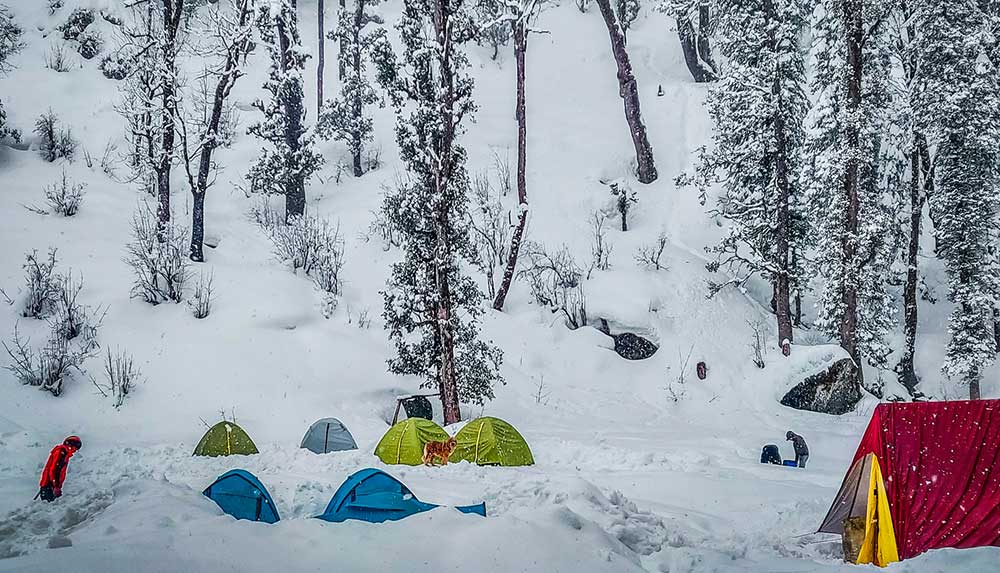
A little preparation goes a long way in making your Kedarkantha journey comfortable and memorable.
Here’s how you can get yourself trek-ready:
1. Build Your Walking Stamina
Start walking 4–5 km daily at a steady pace. Try doing this for 10–15 days before the trek.
If your area has slight inclines, even better, it simulates mountain terrain.
2. Strengthen Your Legs
Strong legs mean less fatigue and more enjoyment.
Include simple exercises like:
- Squats (3 sets × 15 reps)
- Lunges (2 sets × 12 reps each leg)
- Stair climbing (10–15 minutes daily)
These improve endurance and knee stability.
3. Choose the Right Footwear
Avoid renting shoes at the last minute. Moreover, go for high ankle, waterproof snow trekking shoes with a good grip.
Wear them for a few days before the trek to break them in and avoid blisters.
4. Stay Hydrated (Even If You Don’t Feel Thirsty)
Cold weather reduces your urge to drink water, but the body still needs it. Sip 500 ml–1 litre slowly during trekking hours. You can also drink warm water at camps to stay energised.
5. Master the Art of Layering
Instead of one thick jacket, use 3-4 thin layers you can adjust easily:
- Thermal base layer
- Fleece jacket
- Light down jacket
- Waterproof outer shell
This keeps you warm without sweating, which is key in cold mountains.
Trek That Stays With You
The Kedarkantha trek is not just about the summit. It is about the journey you take through forests, frozen lakes, starry nights, and shared experiences.
Having said that, the Kedarkantha trek distance may seem intimidating at first, but a day-by-day approach makes it achievable for most people with basic fitness. When planned well, choosing the right season, route, and package, it becomes a rewarding experience that stays with you long after the trek ends.
So, if you are seeking a Himalayan adventure that is scenic, beginner-friendly, and deeply fulfilling, Kedarkantha is a perfect choice.

